We Make it Easy for You to Recycle Batteries
Battery Recycling Shipping Requirements
The Customer shall be solely responsible for complying with all Department of Transportation (“DOT”) regulations, including, without limitation 49 CFR 173 (regarding shipment lithium batteries), the Occupational Safety and Health Administration Hazard Communication Standard and any other federal, state and local laws and regulations relating to the packaging, labeling, manifesting and transportation of the batteries to BRME’s facility.
The batteries with an exception to lithium shall be shipped in containers of DOT approved 55 gallon size, made of a material compatible with the batteries contained therein. Such containers are to be banded together, four drums to a pallet. Pallets are to be 44” x 44” square, 4 way entry, constructed out of rough oak or hardwood having ¾” to 1” thick tops and bottoms with 2” x 4” stringers. DOT approved duty rated plastic pallets are satisfactory.
All shipping containers shall be labeled to indicate the hazardous nature of the contents, where applicable, as well as the waste code or waste type.
The Customer’s failure to comply with Federal, State or Local laws and regulations relating to the packaging, labeling, manifesting and transportation of the batteries to BRME’s facility can result in an explosion and a fire, either in transportation or at the receiving facility.
There are many kinds of batteries available today and several are regulated as hazardous materials in transportation that may only be shipped by certified hazmat carriers.
Lithium-Primary and Lithium-Ion Batteries
Both rechargeable and non-rechargeable power sources (battery cells and batter power-packs), common in laptop-computers, cell phones, digital cameras, portable power tools and other small electronic devices, if dropped, crushed or short-circuited; these batteries can release dangerous amounts of heat and may ignite, and are dangerous in fires.


Special regulations apply to shipping these batteries (49 CFR 173). To ship lithium batteries by truck within, to and from the United States, the shipments must meet the criteria shown below.
D.O.T. Shipping Description:
- UN 3480, Lithium-Ion Battery, Class 9, PG II
- UN 3090, Lithium Metal Battery, Class 9, PG II
- Batteries must be packaged in a way to avoid short circuits and taped or separated so that electrically active terminals cannot come into contact with each other. Terminals may be taped or placed in a non-conductive material. The gross weight of the shippable container must be 66 lbs. Maximum
- The shippable container must meet D.O.T. Packaging Group II requirements
- The shipping container must be constructed of Metal, Rigid Plastic, Wood or Rigid Fiberboard.
- The shipping container must be capable of passing a 1.2 meter drop-test in any direction without spillage of the contents of the packaging, damage to the batteries inside or shifting of the contents that could lead to short circuit.
- The shipping container must be marked with an indication that the package contains “lithium metal” or “lithium Ion” cells or batteries.
- The shipping container must be marked with the proper UN number, UN 3480 (Lithium-Ion Batteries) or UN 3090 (Lithium Metal Batteries)
- The shipping container must be marked with an indication that the package is to be handled with care and that a flammable hazard exits if the package is damaged.
- The shipping container must be marked with an indication that special procedures must be followed in the event the package is damaged, to include inspection and repacking if necessary.
- The shipping container must be marked with a telephone number for additional information.
- The shipping container must be marked with a Class 9 Label.
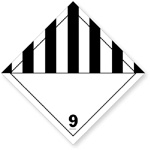 The label must be a background of contrasting color and must be at least 6 mm in height.
The label must be a background of contrasting color and must be at least 6 mm in height. - Unless packed with or contained in equipment, the shippable container must be marked: LITHIUM BATTERIES – FORBIDDEN FOR TRANSPORT ABOARD AIRCRAFT AND VESSEL.” The label must be a background of contrasting color and must be at least 6 mm in height.


Example:

Lead-Acid Batteries (Vented and SSLA)
Common in cars, lead-acid batteries also power electric wheelchairs, computer UPS units, continuous back-up power supply systems, and other emergency power supply applications. These batteries contain a highly corrosive acid (sulfuric) and are capable of causing fires from short circuits.
To ship lead-acid batteries by surface (rail, truck, sea vessel, etc) within, to and from the United States, the shipments must meet the criteria shown below.

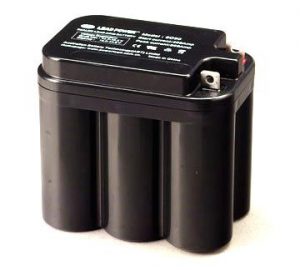
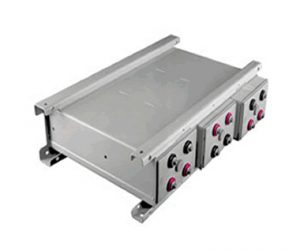
- Batteries must be arranged on a pallet in a manner to prevent short circuits. Batteries terminals must be taped and separated by card board if stacked so that electrically active terminals cannot come into contact with each other.
- Tested, proven Non-Spillable batteries are allowed to be shipped as non-hazardous within the U.S. Batteries and packaging must be marked "NONSPILLABLE" or "NONSPILLABLE BATTERY.
- The shippable container must meet D.O.T. Packaging Group III requirements
- D.O.T. Shipping Description: UN 2800, Batteries, Wet, Non-Spillable, Class 8, PG III
UN 2794, Batteries, Wet, Containing Acid, 8, PG III
- The shippable container must be marked with a Class 8 Label, Corrosive, as shown below. The label must be a background of contrasting color and must be at least 6 mm in height.

Nickel Cadmium, Sealed Cells and Power-Packs
Generally are recognized as batteries used in portable power tools, laptop computers, emergency back-up power supplies, and other portable devices. The battery and power-pack must be packaged in a manner that prevents the generation of a dangerous quantity of heat and short-circuit.
Special regulations apply to shipping these batteries (49 CFR 173). To ship nickel-cadmium batteries and power-packs by surface (rail, truck, sea vessel, etc) within, to and from the United States, the shipments must meet the criteria shown below.


- Batteries must be packaged in a way to avoid short circuits and taped or separated so that electrically active terminals cannot come into contact with each other.
- The shippable container must meet D.O.T. Packaging Group II requirements
- D.O.T. Shipping Description: UN3028, Battery, Dry, Containing Potassium Hydroxide Solid, Class 8, PG II
- The shippable container must be marked with a Class 8 label, Corrosive. The label must be a background of contrasting color and must be at least 6 mm in height.

Nickel-Cadmium, Industrial Cells
Commonly used in Emergency Back-up Power Supplies, Commercial Rail Systems (Class I, II, II, Short-lines and Metro Rail Systems) and military applications. Batteries must be packaged in a manner that prevents the generation of a dangerous quantity of heat and short-circuits.
Special regulations apply to shipping these batteries (49 CFR 173). To ship nickel-cadmium batteries and power-packs by surface (rail, truck, sea vessel, etc) within, to and from the United States, the shipments must meet the criteria shown below.

- The shippable container must meet D.O.T. Packaging Group III requirements
- D.O.T. Shipping Description: UN 2795, Battery, Wet, Filled with Alkaline, Class 8, PG III
- The shippable container must be marked with a class 8 label (As seen above). The label must be a background of contrasting color and must be at least 6 mm in height.

Alkaline (House-hold Batteries)
The common alkaline battery (e.g., House-hold Battery) is not regulated as hazardous materials. When shipped separate from other batteries the insulation of the batteries terminals is not required.
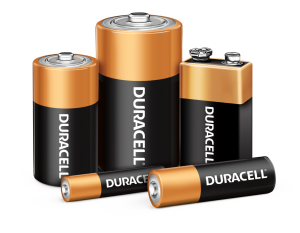
DOT Description, no labeling or packaging required. When shipped with other battery types, then the shipping and packaging requirements of the most stringent battery type will apply.
- D.O.T. Shipping Description: Batteries, Dry, Sealed, N.O.S.
Alkaline – Household Batteries (Over 9 volts)
D.O.T. Shipping Description: UN 3028, Batteries, Dry, Containing Potassium Hydroxide Solid, 8, PG III
If Weight is over 1,000lb “RQ” (Reportable Quantity) needs to be added to the description
Label Required: Class 8, Corrosive
Nickel Metal Hydride
Found in Electric Vehicles (commercial design and application), Laptop Computers, and Portable-Power Tools, Cellular phones and other electronic devices. As a common sealed cell or power-pack battery it is not regulated as hazardous materials; however the DOT packaging requirements must be met because all batteries can cause fires from short circuits if the battery terminals are not protected.
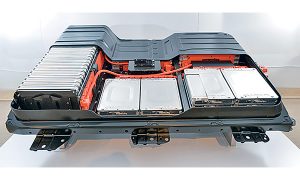
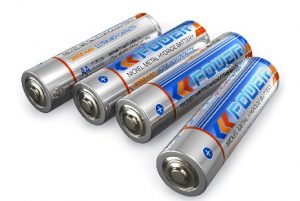
These batteries do not require a D.O.T. Shipping Label.
- D.O.T. Shipping Description: Batteries, Dry, Sealed, N.O.S.
Devices with Batteries
Any device with batteries must not turn on (operate) while in transit. Before shipping, remove the batteries and protect the terminals. Even very simple devices like flashlights or portable-power tools can generate a dangerous quantity of heat if accidentally activated.
Shipping Services
Always use ground services to ship batteries. Never use air services to ship batteries accumulated for recycling for safety reasons, as such shipments are prohibited by regulation (see e.g., IATA Dangerous Goods Regulations, Special Provision A154).
Shipments requiring hazardous-materials handling are accepted from contract hazmat shippers only.
If you have additional questions concerning packaging, placarding, shipping bill requirements, proper DOT descriptions, please contact us.
